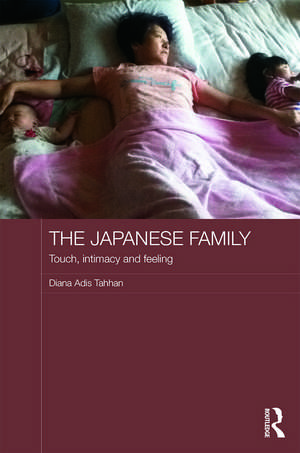The Japanese Family: Touch, Intimacy and Feeling: Japan Anthropology Workshop Series
Autor Diana Adis Tahhanen Limba Engleză Hardback – 8 mai 2014
| Toate formatele și edițiile | Preț | Express |
|---|---|---|
| Paperback (1) | 369.73 lei 6-8 săpt. | |
| Taylor & Francis – 10 mai 2017 | 369.73 lei 6-8 săpt. | |
| Hardback (1) | 1165.27 lei 6-8 săpt. | |
| Taylor & Francis – 8 mai 2014 | 1165.27 lei 6-8 săpt. |
Din seria Japan Anthropology Workshop Series
-
 Preț: 318.29 lei
Preț: 318.29 lei -
 Preț: 310.01 lei
Preț: 310.01 lei - 9%
 Preț: 935.39 lei
Preț: 935.39 lei -
 Preț: 381.21 lei
Preț: 381.21 lei - 16%
 Preț: 261.14 lei
Preț: 261.14 lei -
 Preț: 466.45 lei
Preț: 466.45 lei - 18%
 Preț: 1054.97 lei
Preț: 1054.97 lei - 22%
 Preț: 324.59 lei
Preț: 324.59 lei -
 Preț: 421.61 lei
Preț: 421.61 lei -
 Preț: 193.88 lei
Preț: 193.88 lei -
 Preț: 460.69 lei
Preț: 460.69 lei - 18%
 Preț: 997.42 lei
Preț: 997.42 lei - 18%
 Preț: 1061.57 lei
Preț: 1061.57 lei - 24%
 Preț: 294.77 lei
Preț: 294.77 lei -
 Preț: 449.41 lei
Preț: 449.41 lei - 18%
 Preț: 1057.09 lei
Preț: 1057.09 lei -
 Preț: 444.23 lei
Preț: 444.23 lei -
 Preț: 481.58 lei
Preț: 481.58 lei -
 Preț: 449.05 lei
Preț: 449.05 lei - 18%
 Preț: 272.50 lei
Preț: 272.50 lei - 23%
 Preț: 330.08 lei
Preț: 330.08 lei -
 Preț: 487.37 lei
Preț: 487.37 lei - 18%
 Preț: 1276.61 lei
Preț: 1276.61 lei - 18%
 Preț: 998.53 lei
Preț: 998.53 lei -
 Preț: 469.34 lei
Preț: 469.34 lei -
 Preț: 387.96 lei
Preț: 387.96 lei - 18%
 Preț: 1059.84 lei
Preț: 1059.84 lei -
 Preț: 456.06 lei
Preț: 456.06 lei - 18%
 Preț: 1275.23 lei
Preț: 1275.23 lei -
 Preț: 442.68 lei
Preț: 442.68 lei - 18%
 Preț: 1058.38 lei
Preț: 1058.38 lei - 18%
 Preț: 1166.68 lei
Preț: 1166.68 lei
Preț: 1165.27 lei
Preț vechi: 1421.06 lei
-18% Nou
Puncte Express: 1748
Preț estimativ în valută:
222.97€ • 233.43$ • 184.50£
222.97€ • 233.43$ • 184.50£
Carte tipărită la comandă
Livrare economică 05-19 aprilie
Preluare comenzi: 021 569.72.76
Specificații
ISBN-13: 9780415740289
ISBN-10: 0415740282
Pagini: 184
Ilustrații: 24
Dimensiuni: 156 x 234 x 18 mm
Greutate: 0.5 kg
Ediția:1
Editura: Taylor & Francis
Colecția Routledge
Seria Japan Anthropology Workshop Series
Locul publicării:Oxford, United Kingdom
ISBN-10: 0415740282
Pagini: 184
Ilustrații: 24
Dimensiuni: 156 x 234 x 18 mm
Greutate: 0.5 kg
Ediția:1
Editura: Taylor & Francis
Colecția Routledge
Seria Japan Anthropology Workshop Series
Locul publicării:Oxford, United Kingdom
Public țintă
Postgraduate and UndergraduateCuprins
Foreword Eyal Ben-Ari Part 1 1. Introduction Part 2 2. Parent-child Touch: (Dis)Locating the Body in Skinship 3. Exclusion and Inclusion in the Bedroom Part 3 4. Moving into the Big, Wide World 5. Arriving to a Conceptual Understanding of Belonging Through the Felt Meanings of Touch 6. How Touch Feels after Five 7. Conclusion
Recenzii
'[The Japanese Family] provides a superb, empirically rich, addition to our understanding not only of this specific society but of intimacy and closeness as conceptual tools for analyzing human relations in general. In addition, it draws upon both Japanese sociologies of emotions and those produced in the English-using academic world to propose innovative ways of looking at this special character of relationships. In this rich and sophisticated ethnography Diana thus seeks to explore how the visceral touch between bodies is related to the other types of closeness transmitted not necessarily through actual bodily contact. [...] Diana’s ethnography offers us a new way of looking at families and inter-personal relations, and at intimacy and feeling. Readers are invited into the special, at times magical, world of intimacy and closeness.' – Eyal Ben-Ari, Hebrew University of Jerusalem, Israel
Threaded through Tahhan’s book are understandings of relationality, intimacy, and connectedness as exclusively positive, equitable, and inclusive. Her book represents an ambitious project to examine the daily practices that constitute familial intimacy without continued physical contact between family members. - Kathryn E. GOLDFARB, McMaster University
Threaded through Tahhan’s book are understandings of relationality, intimacy, and connectedness as exclusively positive, equitable, and inclusive. Her book represents an ambitious project to examine the daily practices that constitute familial intimacy without continued physical contact between family members. - Kathryn E. GOLDFARB, McMaster University
Descriere
This book explores how the relationship between child and parent develops in Japan, from the earliest point in a child's life, through the transition from family to the wider world, first to playschools and then schools. It relates the position in Japan to theoretical writing, in both Japan and the West, on body, mind, intimacy and feeling, and compares the position in Japan to practices elsewhere. Overall, the book makes a significant contribution to the study of and theories on body practices, and to debates on the processes of socialisation in Japan.










